Hiro Clinic offers early NIPT testing

NIPT is a test that examines chromosomal abnormalities in a baby’s blood from the mother during pregnancy, obtained through maternal blood sampling. This allows for the assessment of risks for chromosomal abnormalities such as Down syndrome. NIPT can be performed with minimal burden and presents little to no pain or risk for the mother or baby. However, NIPT is considered a screening test and not a definitive diagnosis. If abnormalities are detected, further precision testing is necessary.
Previously, it was believed that NIPT testing before 10 weeks of pregnancy was impossible. However, through collaborative research with the Tokyo Health Laboratory, Hiro Clinic’s NIPT testing has become possible from the point when fetal heartbeat can be confirmed via ultrasound. It can examine not only genetic abnormalities like trisomy 21, 18, and 13 but also all tests including partial and complete chromosome losses and duplications, microdeletions, autosomal, and recessive inheritance.
NIPT (Non-Invasive Prenatal Testing)
How to read ‘prenatal diagnosis’
‘shusseimae shidan’
‘shusshomae shidan’
which are the two main readings.
This consists of a combination of the words ‘prenatal’ and ‘diagnostic’, with ‘birth’ generally read as ‘shussei’, although in medical terminology it is sometimes read as ‘shussei’.
In particular, the reading ‘shussei mae shidan’ is used in the medical field and elsewhere.
What is NIPT

NIPT is the test for ‘blood taken from the mother and the foetus, Down syndrome, Chromosome 18 trisomy (Edwards syndrome), Chromosome 13 trisomy (Patau syndrome), etc. In recent years, not only has the technology been established to detect the number of all chromosomes, but it is also possible to tell if a chromosome is partially missing or duplicated.’
Compared to conventional prenatal diagnosis, the test itself is extremely accurate, with sensitivity and specificity close to 100%.
Compared to conventional prenatal diagnosis, the test itself is extremely accurate, with sensitivity and specificity close to 100%.
Features and benefits of NIPT
No risk to the foetus.
Risks such as miscarriage exist in prenatal diagnostic amniotic fluid tests (1/300) and chorionic villus tests (1/100).
The decision is made in conjunction with an ultrasound and other imaging studies.
NIPT is a safe test with no risk of miscarriage, as the test can be performed with a blood sample from the mother’s arm.

Can be tested if pregnancy is confirmed by echocardiography
Conventional nonconfirmatory tests such as maternal serum markers and combined tests could not be tested until after 11 weeks of pregnancy at the earliest.
NIPT can be taken once the pregnancy is confirmed by an ultrasound, so that the baby’s condition can be known earlier.

High inspection accuracy
There are two criteria for measuring the accuracy of chromosome testing.
Sensitivity, the probability that the test was positive among pregnant women who were positive after delivery, and specificity, the probability that the test was negative among those who were negative after delivery. The higher these values are, the higher the accuracy.
For 21-trisomies, NIPT has a sensitivity of 99.9% and a specificity of 99.90%, which means that the test is more accurate in detecting whether a baby has a possible chromosomal abnormality.
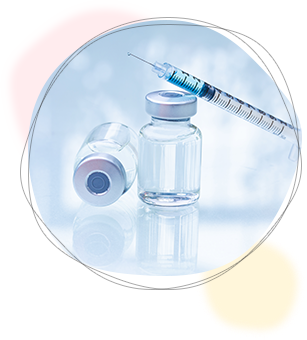
Hiro Clinic NIPT offers positive score report based on data from pregnant women who have been tested with a number of plans and options exclusive to Hiro Clinic. Click here for more information.
Results of NIPT
Test results are given as ‘negative’ or ‘positive’; positive scores are given for positive chromosome 21, 18 and 13 trisomies. This is a number that indicates how likely the disease is based on the genetic information. The positive score is automatically calculated based on the mother’s age and the number of weeks of pregnancy, while the positive score is a number that indicates the degree of genetic abnormality and is only available at Hiro Clinic.
However, the test may not be possible if the amount of the baby’s DNA in the sample (blood) does not meet the criteria or due to medication being taken.
In this case, the blood is ‘re-collected’.
How is NIPT a screening test?
Screening tests are positioned to detect disease in people who do not show any symptoms. It differs from a normal test in the following ways.
1.Must not involve risks.
2.Do not mistakenly turn positive cases negative.
These two points are very different.
Therefore, if the NIPT result is positive, a definitive diagnosis (amniocentesis) should always be made.
Amniotic fluid testing is risky because a needle is inserted into the abdomen, but it is unavoidable to make a diagnosis.
No matter how high the sensitivity and specificity (accuracy) of NIPT is, it is dangerous to make a diagnosis with only one test.
Imagine, for example, a cancer test.
Only after a CT, MRI or biopsy is a diagnosis made. Of course, there are various risks involved, but we do the tests because the benefits outweigh the risks.
With screening tests, that risk is reduced to as little as possible.
Another difference from a definitive diagnosis is that if there is even the slightest suspicion of a positive test result, the test is considered positive. In screening tests, we are not concerned about false positives.
Even in the case of a wrongly positive result, we consider it to be a step to facilitate a definitive diagnosis.
Two types of NIPT tests are available at the hospital. If one of the tests is positive, we assume it is positive.
This is because NIPT is a screening test.
In recent years, an increasing number of laboratories in the country are accepting NIPT tests.
However, it is important to find out in advance the differences between inspection plans and inspection processes, as these vary from one inspection organisation to another.
To give an example, many laboratories have stated that they will only report the results of three of the most frequently detected cases of NIPT: 21 trisomy (Down syndrome)や18 trisomy (Edwards syndrome)、13 trisomy (Patau syndrome).
In addition, not all laboratories offer screening tests under the same conditions. The following is an overview of the NIPT test content.
- Positive or negative
- Aneuploidy detection
- Partial deletion or partial duplication of a gene
- Microdeletion syndrome
There is no provision for NIPT to test for all chromosomal conditions and birth defects, and the tests vary from laboratory to laboratory.
NIPT is also considered to be able to determine the sex of the baby with a high degree of accuracy through sex chromosome testing. As it is not a visual identification test like ultrasound (echography), it is less likely to misjudge the sex of the baby. There are cases where a child may appear to be a girl but genetically has a Y chromosome. One example is an abnormality of the male hormone receptor. Even if male hormones are produced, if there is an abnormality on the side that recognises them, the child cannot be a boy. (Humans are inherently female-formed.)
Opinions and arguments against NIPT have recently been covered by the media, including Japanese television and newspapers. On the other hand, public opinion and some experts have expressed various opinions mainly on ethical issues. However, NIPT is not only a test to determine the risk of chromosomal abnormalities in the foetus, but also to identify the risk of miscarriage in the early stages of pregnancy; NIPT is an important test for a safe and healthy pregnancy.
At Hiro Clinic NIPT, doctors familiar with NIPT will examine you and explain the condition of the foetus in simple, easy-to-understand language.
Fees for NIPT
The cost of NIPT in Japan varies widely from one laboratory to another, ranging from about JPY 90,000 to 240,000 (excluding tax) for tests for 21, 18 and 13 trisomies only.
Hiro Clinic’s NIPT offers the Basic Plan H (JPY 53,680 incl. tax) to the Basic Plan F (JPY 230,780 incl. tax), which performs all chromosome tests that can be searched by the VeriSeq NIPT Solution V2. For details on test plans and costs, see ‘Prenatal Diagnosis Test Plans‘.
Flow of NIPT testing at Hiro Clinic NIPT
The testing process for NIPT varies widely from agency to agency.
In order to reduce waiting times, Hiro Clinic NIPT is available by appointment only and follows the process below.
Please note that you may have to wait depending on how busy the restaurant is at the time of booking. Please be aware of this in advance. For more information, please refer to the ‘Inspection Guide‘.
1.Web booking
After making a provisional appointment via the booking website, fill in the medical questionnaire, confirm the NIPT consent form and watch the video with images.
2.Visit the clinic (medical examination, blood sampling)
Watch a video explaining NIPT, fill in a medical questionnaire and consent form, and have a medical examination and blood sampling by a doctor.
3.Receive the results
Results are delivered within 8 days of blood collection in 95% of cases.(※Except for some plans)
The express delivery option is available at all Hiro Clinic NIPT clinics except for the collaborating facilities. (Delivered in as little as two days after blood collection)
What is prenatal testing?
About prenatal testing
‘Prenatal testing’ refers to tests to check the developmental status and morphological abnormalities of the baby in the mother’s womb. It is called prenatal testing because it is carried out before the birth of the baby.
Prenatal testing may be associated with genetic testing and special tests, but prenatal testing also includes imaging tests that have generally been performed during antenatal check-ups, such as routine ultrasound examinations (echocardiography) and foetal heart rate monitoring.
Prenatal tests can be broadly divided into imaging tests to visually examine morphological and functional abnormalities, tests to extract foetal DNA from maternal blood for gene and hormone levels, and tests to examine amniotic fluid and chorionic villi.
These can be classified into two types of prenatal tests: non-invasive tests, such as ultrasound and maternal blood tests, which cause little damage to the foetus, and invasive tests, such as puncturing the mother and extracting placental tissue, which carry the risk of miscarriage.
The doctor’s overall judgment of the findings of these prenatal tests is also known as a ‘prenatal diagnosis’.
Purpose of prenatal testing
The advantage of having a prenatal test is that it can prepare you for the birth. Of course, it is preferable that the foetus is developing well, but prenatal testing can help to avoid and deal with unforeseen circumstances.
- When the birth is scheduled later or earlier than usual.
- If the echo test suggests that the patient may have a disease of a serious organ, such as the heart or kidneys.
- When inborn errors of metabolism or chromosomal abnormalities are known from genetic testing
- In cases of multiple births, such as twins.In cases of multiple births, such as twins.
- When the orientation of the foetus in the womb is different from normal, as in a breech baby.
By obtaining the above-mentioned foetal information through prenatal testing, it is possible to select a delivery facility and arrange for a neonatal intensive care unit (NICU) in advance. These factors can help to ensure that the newborn baby is welcomed in the most suitable environment.
In addition, many people are concerned that if one of their relatives has a congenital disorder or genetic abnormality, their baby may have a similar condition. However, advances in medical technology, such as NIPT, now make it possible to find out early in pregnancy whether a foetus has a possible chromosomal abnormality.
Hiro Clinic ‘s NIPT (Neo-Interventional Prenatal Testing) is considered a test that respects the right of pregnant women and their families to know and to have a healthy pregnancy period and delivery. Another purpose of NIPT is to share the health status of the foetus with the couple, partner and family before the birth, so that the whole family can prepare to welcome the baby.
Types and features of prenatal testing
NIPT, a new type of prenatal test, has attracted the most attention in recent years and was introduced in 2013 in Japan.
The major difference between conventional prenatal testing and NIPT is that NIPT is a very low-impact test, requiring only a blood sample from the mother, and in the case of 21 trisomies, it is highly accurate, with a sensitivity of 99.9% and specificity of 99.9% (for 21, 18 and 13 trisomies) for detecting foetal chromosomal abnormalities. The test is highly accurate, with a sensitivity of 99.9% and specificity of 99.9% (for 21, 18 and 13 trisomies).
NIPT is a non-invasive prenatal genetic test performed by drawing blood similar to a general health examination. It can determine the baby’s risk of chromosomal abnormalities from the foetal DNA present in the mother’s blood.
This test was made possible by the development of next-generation sequencing technology, and NIPT is said to be the most successful test using next-generation sequencers.
The three chromosomal abnormalities that can be detected by NIPT are 21trisomy (Down syndrome)・18 trisomy (Edwards syndrome) and 13 trisomy (Patau syndrome) which account for 50% of all chromosomal abnormalities.
NIPT has been improved over the years, and it is now possible to determine with a high degree of accuracy not only 21, 18 and 13 trisomies, but also the risk of abnormalities in sex chromosomes and all autosomal chromosome numbers from 1 to 22. It is also now possible to report cases of abnormalities in some chromosomes, such as microdeletion syndrome and partial deletion-partial duplication.
Click here for a list of diseases that can be tested for with Hiro Clinic NIPT.
It is also possible to determine cases with many (duplications) or few (deletions) chromosomes with a high degree of accuracy as well.
For information on partial duplicates and deletions, see here.
Note that NIPT is not a definitive diagnosis of the baby’s chromosomal disease, but is positioned as a so-called non-conclusive test that diagnoses the possibility of the disease. Thus, prenatal testing includes non-confirmatory and confirmatory tests, which are also referred to as non-invasive and invasive tests.
The differences between definitive and nonconfirmatory tests are as follows
| Nonconfirmatory test | Ultrasound (e.g. early NT) imaging to assess possible chromosomal disease |
|---|---|
| Maternal serum marker testing (Quattro test, triple marker test) | |
| Combined testing | |
| Maternal blood foetal chromosome testing (NIPT is also positioned here) | |
| Definitive test | Chorionic villus testing (11-14 weeks) |
| Amniotic fluid testing (from 15 weeks onwards) |
What is nonconfirmatory test?
A test performed to assess whether the foetus has a possible chromosomal abnormality.
The tests are considered to have a very low risk of miscarriage because they are less stressful on the mother and do not directly invade (damage) the foetus.
These tests are called ‘non-confirmatory (non-invasive) tests’ and several types of tests are listed: NIPT is one type of non-confirmatory test. NIPT is also referred to as non-invasive prenatal genetic testing (non-invasive prenatal genetic testing/non-invasive prenatal genetic testing).
Non-conclusive tests determine the risk of disease due to chromosomal abnormalities. Definitive tests such as amniofiltration and chorionic villus tests are required for a definitive diagnosis.
The amniotic fluid test is performed after 15 weeks of pregnancy and the results are available 2-3 weeks later, so it takes longer to obtain a definitive diagnosis.
What is ultrasonography (echocardiography)?
Ultrasound examination (echo examination) is a diagnostic examination in which a machine is applied to the mother’s abdomen with a jelly-like lubricant on top to provide images of the growth and health of the foetus in the abdomen. This test is also performed on all pregnant women during general antenatal check-ups.
Ultrasound examination (echocardiography) allows the growth and health of the foetus to be monitored at each gestational week. In addition, the thickness of the back of the foetal neck (NT) and the development of the foetus often point to foetal diseases.In 3D and 4D ultrasound examinations, it is possible to detect various diseases, such as heart disease, cleft palate, cleft lip, polydactyly and renal disease.
Ultrasonography (echography) can be performed from early to late pregnancy. However, because ultrasound (echography) is a diagnostic imaging test, it can diagnose foetal morphological abnormalities, but not chromosomal abnormalities.
In order to examine the health of the foetus in more detail, Hiro Clinic NIPT proposes a ‘chromosome screening test’ by NIPT in addition to a ‘visual diagnosis’ by ultrasound (echo examination).
Maternal serum marker testing (triple marker quattro test/quattro test)
This method measures hormones and proteins of foetal or placental origin in maternal blood serum and calculates the probability that the foetus has a chromosomal abnormality or open neural tube malformation. As the test is carried out using only a blood sample from the mother, there is no direct invasion (damage) to the foetus and the risk of miscarriage is considered to be very low. However, the sensitivity and specificity of both methods are low, so they are not useful for testing for trisomies such as Down syndrome, and must be regarded as old technology. They can be useful in diagnosing anencephaly and spina bifida, but this is also not very useful as it can be detected by echocardiography. It is thought to be a test that will become obsolete in the future.
What is triple marker?
A blood sample is taken from the mother to determine the levels of maternal proteins alpha-fetoprotein (AFP) and hormones called human chorionic gonadotropin (hCG) and unconjugated estriol (uE3). Compared with NIPT, this test is now rarely performed due to its low accuracy.
What is Quattro test (Quattro test)?
This test is a triple marker plus inhibin A.
Serum marker testing in Japan refers to the Quadruple test (Quattro test/Quattro test). This test is performed at 15-17 weeks’ gestation. It is estimated to take 7-10 days before results are available.
The Quattro test is not recommended by Hiro Clinic NIPT due to its low accuracy. A combination of ultrasound (echography) and NIPT covers the range of the Quattro test and provides a more accurate diagnosis.
Combined test
This test combines the measurement of NT (Nuchal Translucency) by ultrasonography and the measurement of serum markers (PAPP-A, hCG) by blood sampling, and is called a combined test because the two tests are combined.
The probability of 21 trisomy (Down syndrome), 18 trisomy (Edwards syndrome) in the foetus is calculated.This test was widely used before the NIPT test, but like the quattro test, it has problems with low accuracy and, because the NIPT. In recent years, there has been a shift to NIPT around the world, as it can cover the area of combined testing.
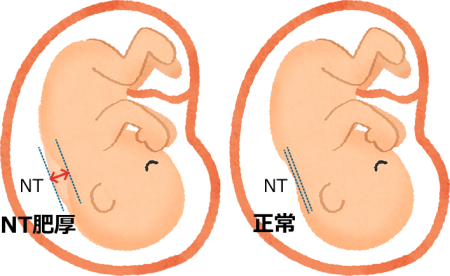
NIPT/non-invasive (non-invasive) prenatal genetic testing/ maternal blood foetal chromosome testing
NIPT is a type of prenatal screening test. The test is considered to determine the risk of disease due to chromosomal abnormalities by measuring DNA fragments suspended in blood taken from the mother.
NIPT can be performed as soon as an echo shows a foetal heartbeat. The test is also considered highly accurate, with a sensitivity and specificity for 21 trisomy (Down syndrome) of 99.9%. However, NIPT is only a non-confirmatory test. If a definitive diagnosis is desired, a definitive test such as an amniotic fluid test is required.
What is definitive test?
A test that reliably tests for the presence or absence of a disease is called a definitive test. The test looks at the chromosomes themselves after culturing cells present in the amniotic fluid or chorionic villi tissue.
Amniotic fluid test
The foetus floats in amniotic fluid in the womb. The amniotic fluid contains the foetus’ cells. The cells in the amniotic fluid are sampled and examined for changes in chromosomes and DNA. The position of the foetus is confirmed on the image while ultrasound is applied to the abdomen, and a needle is inserted into the mother’s abdomen to collect approximately 20 ml of amniotic fluid. The collected cells can be cultured for G-band testing and genetic testing such as qfPCR and microarray testing.
The amniotic fluid test is a definitive test, but there is a risk of miscarriage or water breakage of about 0.3% because the test is performed with a needle in the abdomen. It also takes approximately 2-4 weeks for the results to be available. As with all tests, it is not 100% definitive. A positive amniotic fluid test is of course wrong, but even a negative result cannot be absolutely negative.
Chorionic test
Trophoblastic testing is a test for genetic abnormalities by obtaining cells from the trophoblasts of foetal origin. It can be performed early in pregnancy, but is now considered an infrequently performed test because the cells are derived from the placenta and not completely from the foetus. Also, as the foetus and placenta can have different genes, Hiro Clinic NIPT believes that an amniotic fluid test is necessary for an accurate diagnosis.
What NIPT can tell you
The diseases and items that can be detected by NIPT vary from facility to facility.
For example, NIPT facilities accredited by the Japanese Association of Medical Sciences can only detect 21 trisomy (Down syndrome)・18 trisomy (Edwards syndrome)・13 trisomy (Patau syndrome).
Diseases and test items identified by Hiro Clinic NIPT.
Hiro Clinic NIPT works in partnership with the Tokyo Sanitary Laboratory to ensure that pregnant women have the right to know the results of the test as soon as possible, and to provide the information they request.
The test results of the Hiro Clinic NIPT test are as follows.
For more information on the diseases that can be detected by the test, please refer to ‘About the diseases that can be detected by NIPT’.
Whole chromosome aneuploidy
Hiro Clinic NIPT can detect aneuploidy (abnormal number of chromosomes) not only in trisomy, which consists of three chromosomes, but also in other numbers such as monosomy.
Autosomal (chromosomes 1 to 22) aneuploidy
Hiro Clinic NIPT can detect aneuploidy (abnormal numbers) for all chromosome 1 to 22, as well as chromosomes 21, 18 and 13. As mentioned above, not only trisomy but also monosomy can be detected. There is also a stand-alone plan available, which includes testing for chromosome 21 (Down syndrome) only.
Major diseases that can be detected by testing for aneuploidy of all chromosomes
Determination of gender chromosome aneuploidy
Aneuploidy (abnormal numbers) of sex chromosomes (X and Y chromosomes), such as Turner syndrome, a monosomy with only one X chromosome, or Klinefelter syndrome, a trisomy with many X chromosomes, will be informed.
Gender determination
You will be informed of the gender of your baby.
In the case of twins, the decision will be based on whether there is a Y chromosome, so you will be informed whether you are having a boy or not.
- Both girls
- Either one or both boys
Total autosomal whole-region partial deletion/duplication disease
We will inform you about anomalies that are not abnormalities in the number of chromosomes, such as monosomy or trisomy, but rather duplications or deletions of part of a chromosome. Hiro Clinic NIPT will inform you if you have more than 7 million bases missing or duplicated.
The test content varies depending on the plan. Please consider which testing plan you and your family prefer.
Principles of NIPT
The length of each gene is estimated to be 50-200 bp.
The bp is the unit for the number of A, G, T and C sequences.
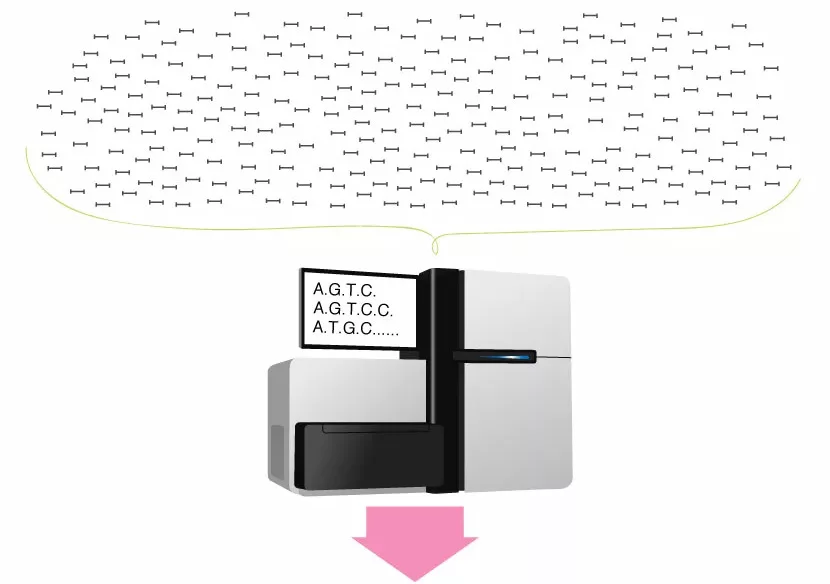
The gene sequence is read by a sequencer (sequence decoding device)
and analysed by a computor to determine which position in the human gene it came from.
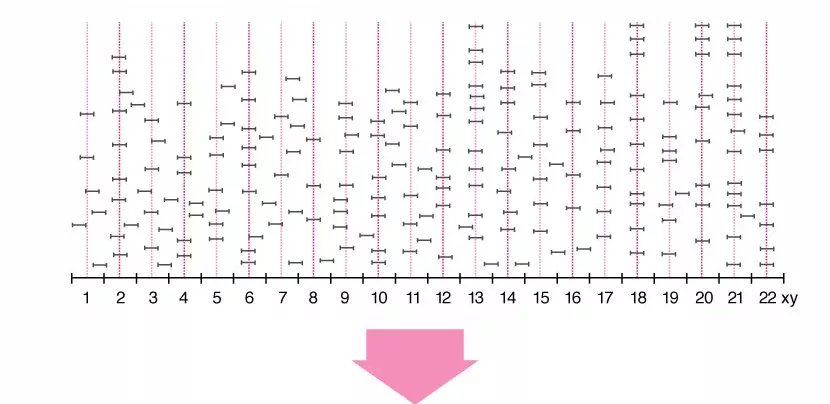
The number of sequences present in each region of a gene is measured and
corrected to measure the distribution of gene abundance.
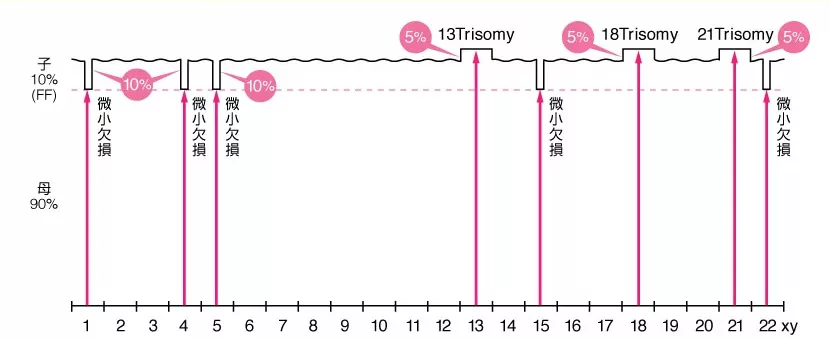
Length distribution of cfDNA in plasma. The blue line is cfDNA of foetal origin and the red line is total cfDNA.
This difference in length is used to determine the proportion of cfDNA of foetal origin (FF)
from the total cfDNA flowing in the mother.
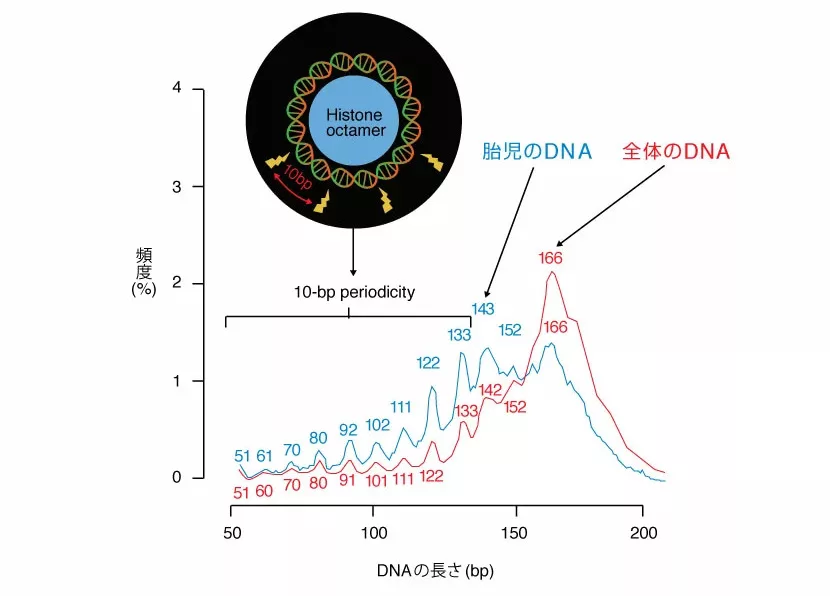
[引用]Lo YM1, Chan KC, Sun H, Chen EZ, Jiang P, Lun FM, Zheng YW, Leung TY, Lau TK, Cantor CR, Chiu RW. Maternal plasma DNA sequencing reveals the genome-wide genetic and mutational profile of the fetus.Sci Transl Med. 2010 Dec 8;2(61)
The ratio of cfDNA (FF) gradually increases as the number of weeks of pregnancy progresses.
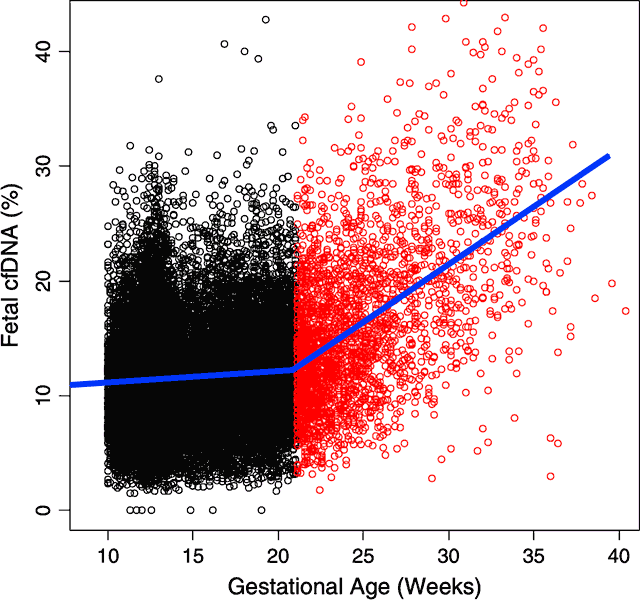
About Streck tube
Hiro Clinic NIPT uses STRECK’s Cell-Free DNA BCT as the blood collection tube.
Cell-Free DNA BCT is a blood collection tube that stabilises Cell-Free DNA at 6°C to 37°C for up to 14 days and CTCs at 15°C to 30°C for up to 7 days.
About NIPT at Hiro Clinic NIPT
Hiro Clinic NIPT offers a unique test based on the vast amount of data from NIPT that has been conducted to date.
Hiro Clinic NIPT can promptly respond to the ‘right to know’ of pregnant women and their families by cooperating with a domestic health laboratory, the Tokyo Sanitary Laboratory. We also offer a variety of NIPT plans and options to reduce the number of “I was NIPT negative…”.
While most testing facilities only detect trisomies, Hiro Clinic NIPT also reports monosomies. We also report diseases caused by whole autosomal partial deletions or duplications of more than 7 million bases.
At Hiro Clinic NIPT, specialists from the Japan Society of Obstetrics and Gynaecology are on staff, and at the Nagoya Ekimae Clinic, Omiya Ekimae Clinic (Mon, Fri, Sat and Sun) and Osaka Ekimae Clinic (Mon, Thu, Sat and Sun) ultrasound examinations (echography) are also available before NIPT. The doctors and staff are well versed in NIPT, so anyone can undergo the examination and NIPT with reassurance.
Please click here to find out which clinics offer this service.
Hiro Clinic offers amniotic fluid testing support and subsidises the cost of amniotic fluid testing up to JPY 200,000 (incl. tax) for those with a positive test result.
For more information, please see Hiro Clinic NIPT Fees and Features.
Q&A
FAQs
Some frequently asked questions about NIPT are listed below for references.
-
QWhat does the NIPT test tell you?
 A test in which blood samples are taken from the mother to check for chromosomal abnormalities in the foetus, such as Down syndrome, chromosome 18 trisomy (Edwards syndrome) and chromosome 13 trisomy (Patau syndrome).
A test in which blood samples are taken from the mother to check for chromosomal abnormalities in the foetus, such as Down syndrome, chromosome 18 trisomy (Edwards syndrome) and chromosome 13 trisomy (Patau syndrome).
Hiro Clinic can detect all chromosome counts and can also tell if there are partial defects or duplications. -
QIf NIPT is negative, is it safe?
 Although the ‘negative predictive value’ is very high – 99.9% in all age bands – NIPT is a non-confirmatory test to determine the risk of disease due to chromosomal abnormalities.
Although the ‘negative predictive value’ is very high – 99.9% in all age bands – NIPT is a non-confirmatory test to determine the risk of disease due to chromosomal abnormalities.
Definitive tests such as amniocentesis and chorionography are required for a definitive diagnosis. -
QHow much does the NIPT test cost?
 A test to test for chromosomal abnormalities such as Down syndrome in the foetus from blood taken from the mother NIPT generally costs around JPY 200,000.
A test to test for chromosomal abnormalities such as Down syndrome in the foetus from blood taken from the mother NIPT generally costs around JPY 200,000.
At Hiro Clinic, testing for Down syndrome is available for JPY 33,000 (JPY 36,300 including tax).
Video of Hiro Clinic
The clinic was featured in a special edition of Wake Up!
 中文
中文









